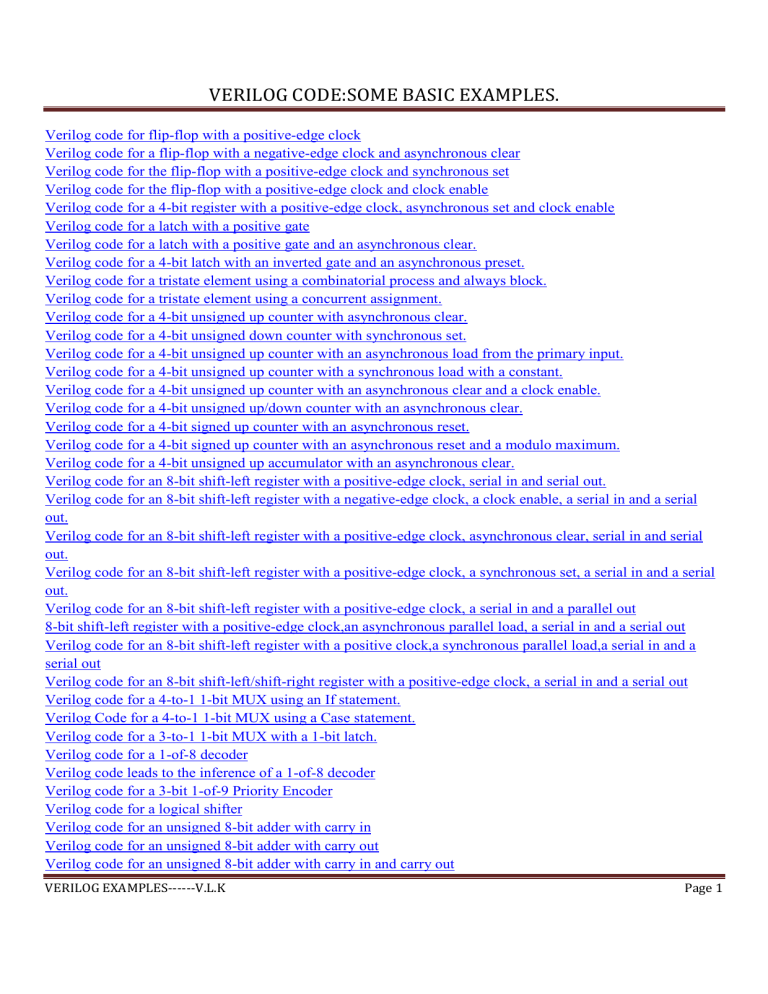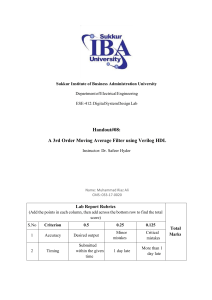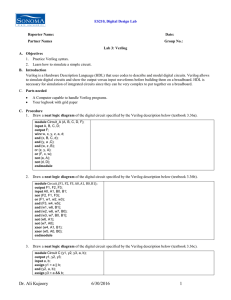
VERILOG CODE:SOME BASIC EXAMPLES.
Verilog code for flip-flop with a positive-edge clock
Verilog code for a flip-flop with a negative-edge clock and asynchronous clear
Verilog code for the flip-flop with a positive-edge clock and synchronous set
Verilog code for the flip-flop with a positive-edge clock and clock enable
Verilog code for a 4-bit register with a positive-edge clock, asynchronous set and clock enable
Verilog code for a latch with a positive gate
Verilog code for a latch with a positive gate and an asynchronous clear.
Verilog code for a 4-bit latch with an inverted gate and an asynchronous preset.
Verilog code for a tristate element using a combinatorial process and always block.
Verilog code for a tristate element using a concurrent assignment.
Verilog code for a 4-bit unsigned up counter with asynchronous clear.
Verilog code for a 4-bit unsigned down counter with synchronous set.
Verilog code for a 4-bit unsigned up counter with an asynchronous load from the primary input.
Verilog code for a 4-bit unsigned up counter with a synchronous load with a constant.
Verilog code for a 4-bit unsigned up counter with an asynchronous clear and a clock enable.
Verilog code for a 4-bit unsigned up/down counter with an asynchronous clear.
Verilog code for a 4-bit signed up counter with an asynchronous reset.
Verilog code for a 4-bit signed up counter with an asynchronous reset and a modulo maximum.
Verilog code for a 4-bit unsigned up accumulator with an asynchronous clear.
Verilog code for an 8-bit shift-left register with a positive-edge clock, serial in and serial out.
Verilog code for an 8-bit shift-left register with a negative-edge clock, a clock enable, a serial in and a serial
out.
Verilog code for an 8-bit shift-left register with a positive-edge clock, asynchronous clear, serial in and serial
out.
Verilog code for an 8-bit shift-left register with a positive-edge clock, a synchronous set, a serial in and a serial
out.
Verilog code for an 8-bit shift-left register with a positive-edge clock, a serial in and a parallel out
8-bit shift-left register with a positive-edge clock,an asynchronous parallel load, a serial in and a serial out
Verilog code for an 8-bit shift-left register with a positive clock,a synchronous parallel load,a serial in and a
serial out
Verilog code for an 8-bit shift-left/shift-right register with a positive-edge clock, a serial in and a serial out
Verilog code for a 4-to-1 1-bit MUX using an If statement.
Verilog Code for a 4-to-1 1-bit MUX using a Case statement.
Verilog code for a 3-to-1 1-bit MUX with a 1-bit latch.
Verilog code for a 1-of-8 decoder
Verilog code leads to the inference of a 1-of-8 decoder
Verilog code for a 3-bit 1-of-9 Priority Encoder
Verilog code for a logical shifter
Verilog code for an unsigned 8-bit adder with carry in
Verilog code for an unsigned 8-bit adder with carry out
Verilog code for an unsigned 8-bit adder with carry in and carry out
VERILOG EXAMPLES------V.L.K
Page 1
VERILOG CODE:SOME BASIC EXAMPLES.
Verilog code for an unsigned 8-bit adder/subtractor
Verilog code for an unsigned 8-bit greater or equal comparator
Verilog code for an unsigned 8x4-bit multiplier
Verilog template shows the multiplication operation placed outside the always block and the pipeline stages
represented as single registers
Verilog template shows the multiplication operation placed inside the always block and the pipeline stages are
represented as single registers
Verilog template shows the multiplication operation placed outside the always block and the pipeline stages
represented as single registers
Verilog template shows the multiplication operation placed inside the always block and the pipeline stages are
represented as single registers
Verilog template shows the multiplication operation placed outside the always block and the pipeline stages
represented as shift registers
Use templates to implement Multiplier Adder with 2 Register Levels on Multiplier Inputs in Verilog
Verilog code for resource sharing
single-port RAM in read-first mode
single-port RAM in write-first mode
single-port RAM in no-change mode
single-port RAM with asynchronous read
single-port RAM with "false" synchronous read
single-port RAM with synchronous read (read through)
Verilog code for a single-port block RAM with enable
Verilog code for a dual-port RAM with asynchronous read
Verilog code for a dual-port RAM with false synchronous read
Verilog code for a dual-port RAM with synchronous read (read through)
Verilog code for a dual-port RAM with enable on each port
Verilog code for a ROM with registered output
Verilog code for a ROM with registered address
Verilog code for an FSM with a single process
Verilog code for an FSM with two processes
Verilog code for an FSM with three processes
VERILOG EXAMPLES------V.L.K
Page 2
VERILOG CODE:SOME BASIC EXAMPLES.
Following is the Verilog code for flip-flop with a positive-edge clock.
module
input
output
reg
flop (clk, d, q);
clk, d;
q;
q;
always @(posedge clk)
begin
q <= d;
end
endmodule
Following is Verilog code for a flip-flop with a negative-edge clock and asynchronous clear.
module flop (clk, d, clr, q);
input clk, d, clr;
output q;
reg
q;
always @(negedge clk or posedge clr)
begin
if (clr)
q <= 1’b0;
else
q <= d;
end
endmodule
Following is Verilog code for the flip-flop with a positive-edge clock and synchronous set.
module flop (clk, d, s, q);
input clk, d, s;
output q;
reg
q;
always @(posedge clk)
begin
if (s)
q <= 1’b1;
else
q <= d;
end
endmodule
VERILOG EXAMPLES------V.L.K
Page 3
VERILOG CODE:SOME BASIC EXAMPLES.
Following is Verilog code for the flip-flop with a positive-edge clock and clock enable.
module flop (clk, d, ce, q);
input clk, d, ce;
output q;
reg
q;
always @(posedge clk)
begin
if (ce)
q <= d;
end
endmodule
Following is Verilog code for a 4-bit register with a positive-edge clock, asynchronous set and clock
enable.
module flop (clk, d, ce, pre, q);
input
clk, ce, pre;
input [3:0] d;
output [3:0] q;
reg
[3:0] q;
always @(posedge clk or posedge pre)
begin
if (pre)
q <= 4’b1111;
else if (ce)
q <= d;
end
endmodule
Following is the Verilog code for a latch with a positive gate.
module latch (g, d, q);
input g, d;
output q;
reg
q;
always @(g or d)
begin
if (g)
q <= d;
end
endmodule
VERILOG EXAMPLES------V.L.K
Page 4
VERILOG CODE:SOME BASIC EXAMPLES.
Following is the Verilog code for a latch with a positive gate and an asynchronous clear.
module latch (g, d, clr, q);
input g, d, clr;
output q;
reg
q;
always @(g or d or clr)
begin
if (clr)
q <= 1’b0;
else if (g)
q <= d;
end
endmodule
Following is Verilog code for a 4-bit latch with an inverted gate and an asynchronous preset.
module latch (g, d, pre, q);
input
g, pre;
input [3:0] d;
output [3:0] q;
reg
[3:0] q;
always @(g or d or pre)
begin
if (pre)
q <= 4’b1111;
else if (~g)
q <= d;
end
endmodule
VERILOG EXAMPLES------V.L.K
Page 5
VERILOG CODE:SOME BASIC EXAMPLES.
Following is Verilog code for a tristate element using a combinatorial process and always block.
module three_st (t, i, o);
input t, i;
output o;
reg
o;
always @(t or i)
begin
if (~t)
o = i;
else
o = 1’bZ;
end
endmodule
Following is the Verilog code for a tristate element using a concurrent assignment.
module three_st (t, i, o);
input t, i;
output o;
assign o = (~t) ? i: 1’bZ;
endmodule
Following is the Verilog code for a 4-bit unsigned up counter with asynchronous clear.
module counter (clk, clr, q);
input
clk, clr;
output [3:0] q;
reg
[3:0] tmp;
always @(posedge clk or posedge clr)
begin
if (clr)
tmp <= 4’b0000;
else
tmp <= tmp + 1’b1;
end
assign q = tmp;
endmodule
Following is the Verilog code for a 4-bit unsigned down counter with synchronous set.
module counter (clk, s, q);
input
clk, s;
output [3:0] q;
reg
[3:0] tmp;
always @(posedge clk)
begin
if (s)
VERILOG EXAMPLES------V.L.K
Page 6
VERILOG CODE:SOME BASIC EXAMPLES.
tmp <= 4’b1111;
else
tmp <= tmp - 1’b1;
end
assign q = tmp;
endmodule
Following is the Verilog code for a 4-bit unsigned up counter with an asynchronous load from the
primary input.
module counter (clk, load, d, q);
input
clk, load;
input [3:0] d;
output [3:0] q;
reg
[3:0] tmp;
always @(posedge clk or posedge load)
begin
if (load)
tmp <= d;
else
tmp <= tmp + 1’b1;
end
assign q = tmp;
endmodule
Following is the Verilog code for a 4-bit unsigned up counter with a synchronous load with a constant.
module counter (clk, sload, q);
input
clk, sload;
output [3:0] q;
reg
[3:0] tmp;
always @(posedge clk)
begin
if (sload)
tmp <= 4’b1010;
else
tmp <= tmp + 1’b1;
end
assign q = tmp;
endmodule
Following is the Verilog code for a 4-bit unsigned up counter with an asynchronous clear and a clock
enable.
VERILOG EXAMPLES------V.L.K
Page 7
VERILOG CODE:SOME BASIC EXAMPLES.
module counter (clk, clr, ce, q);
input
clk, clr, ce;
output [3:0] q;
reg
[3:0] tmp;
always @(posedge clk or posedge clr)
begin
if (clr)
tmp <= 4’b0000;
else if (ce)
tmp <= tmp + 1’b1;
end
assign q = tmp;
endmodule
Following is the Verilog code for a 4-bit unsigned up/down counter with an asynchronous clear.
module counter (clk, clr, up_down, q);
input
clk, clr, up_down;
output [3:0] q;
reg
[3:0] tmp;
always @(posedge clk or posedge clr)
begin
if (clr)
tmp <= 4’b0000;
else if (up_down)
tmp <= tmp + 1’b1;
else
tmp <= tmp - 1’b1;
end
assign q = tmp;
endmodule
Following is the Verilog code for a 4-bit signed up counter with an asynchronous reset.
module counter (clk, clr, q);
input
clk, clr;
output signed [3:0] q;
reg
signed [3:0] tmp;
always @ (posedge clk or posedge clr)
begin
if (clr)
tmp <= 4’b0000;
else
tmp <= tmp + 1’b1;
end
assign q = tmp;
endmodule
VERILOG EXAMPLES------V.L.K
Page 8
VERILOG CODE:SOME BASIC EXAMPLES.
Following is the Verilog code for a 4-bit signed up counter with an asynchronous reset and a modulo
maximum.
module counter (clk, clr, q);
parameter MAX_SQRT = 4, MAX = (MAX_SQRT*MAX_SQRT);
input
clk, clr;
output [MAX_SQRT-1:0] q;
reg
[MAX_SQRT-1:0] cnt;
always @ (posedge clk or posedge clr)
begin
if (clr)
cnt <= 0;
else
cnt <= (cnt + 1) %MAX;
end
assign q = cnt;
endmodule
Following is the Verilog code for a 4-bit unsigned up accumulator with an asynchronous clear.
module accum (clk, clr, d, q);
input
clk, clr;
input [3:0] d;
output [3:0] q;
reg
[3:0] tmp;
always @(posedge clk or posedge clr)
begin
if (clr)
tmp <= 4’b0000;
else
tmp <= tmp + d;
end
assign q = tmp;
endmodule
Following is the Verilog code for an 8-bit shift-left register with a positive-edge clock, serial in and serial
out.
module shift (clk, si, so);
input
clk,si;
output
so;
reg
[7:0] tmp;
always @(posedge clk)
begin
tmp
<= tmp << 1;
VERILOG EXAMPLES------V.L.K
Page 9
VERILOG CODE:SOME BASIC EXAMPLES.
tmp[0] <= si;
end
assign so = tmp[7];
endmodule
Following is the Verilog code for an 8-bit shift-left register with a negative-edge clock, a clock enable, a
serial in and a serial out.
module shift (clk, ce, si, so);
input
clk, si, ce;
output
so;
reg
[7:0] tmp;
always @(negedge clk)
begin
if (ce) begin
tmp
<= tmp << 1;
tmp[0] <= si;
end
end
assign so = tmp[7];
endmodule
Following is the Verilog code for an 8-bit shift-left register with a positive-edge clock, asynchronous clear,
serial in and serial out.
module shift (clk, clr, si, so);
input
clk, si, clr;
output
so;
reg
[7:0] tmp;
always @(posedge clk or posedge clr)
begin
if (clr)
tmp <= 8’b00000000;
else
tmp <= {tmp[6:0], si};
end
assign so = tmp[7];
endmodule
Following is the Verilog code for an 8-bit shift-left register with a positive-edge clock, a synchronous set,
a serial in and a serial out.
module shift (clk, s, si, so);
input
clk, si, s;
VERILOG EXAMPLES------V.L.K
Page 10
VERILOG CODE:SOME BASIC EXAMPLES.
output
so;
reg
[7:0] tmp;
always @(posedge clk)
begin
if (s)
tmp <= 8’b11111111;
else
tmp <= {tmp[6:0], si};
end
assign so = tmp[7];
endmodule
Following is the Verilog code for an 8-bit shift-left register with a positive-edge clock, a serial in and a
parallel out.
module shift (clk, si, po);
input
clk, si;
output [7:0] po;
reg
[7:0] tmp;
always @(posedge clk)
begin
tmp <= {tmp[6:0], si};
end
assign po = tmp;
endmodule
Following is the Verilog code for an 8-bit shift-left register with a positive-edge clock, an asynchronous
parallel load, a serial in and a serial out.
module shift (clk, load, si, d, so);
input
clk, si, load;
input [7:0] d;
output
so;
reg
[7:0] tmp;
always @(posedge clk or posedge load)
begin
if (load)
tmp <= d;
else
tmp <= {tmp[6:0], si};
end
assign so = tmp[7];
endmodule
VERILOG EXAMPLES------V.L.K
Page 11
VERILOG CODE:SOME BASIC EXAMPLES.
Following is the Verilog code for an 8-bit shift-left register with a positive-edge clock, a synchronous
parallel load, a serial in and a serial out.
module shift (clk, sload, si, d, so);
input
clk, si, sload;
input [7:0] d;
output
so;
reg
[7:0] tmp;
always @(posedge clk)
begin
if (sload)
tmp <= d;
else
tmp <= {tmp[6:0], si};
end
assign so = tmp[7];
endmodule
Following is the Verilog code for an 8-bit shift-left/shift-right register with a positive-edge clock, a serial
in and a serial out.
module shift (clk, si, left_right, po);
input
clk, si, left_right;
output
po;
reg
[7:0] tmp;
always @(posedge clk)
begin
if (left_right == 1’b0)
tmp <= {tmp[6:0], si};
else
tmp <= {si, tmp[7:1]};
end
assign po = tmp;
endmodule
Following is the Verilog code for a 4-to-1 1-bit MUX using an If statement.
module mux (a, b, c, d, s, o);
input
a,b,c,d;
input [1:0] s;
output
o;
reg
o;
always @(a or b or c or d or s)
begin
if (s == 2’b00)
o = a;
else if (s == 2’b01)
o = b;
VERILOG EXAMPLES------V.L.K
Page 12
VERILOG CODE:SOME BASIC EXAMPLES.
else if (s == 2’b10)
o = c;
else
o = d;
end
endmodule
Following is the Verilog Code for a 4-to-1 1-bit MUX using a Case statement.
module mux (a, b, c, d, s, o);
input
a, b, c, d;
input [1:0] s;
output
o;
reg
o;
always @(a or b or c or d or s)
begin
case (s)
2’b00
: o = a;
2’b01
: o = b;
2’b10
: o = c;
default : o = d;
endcase
end
endmodule
Following is the Verilog code for a 3-to-1 1-bit MUX with a 1-bit latch.
module mux (a, b, c, d, s, o);
input
a, b, c, d;
input [1:0] s;
output
o;
reg
o;
always @(a or b or c or d or s)
begin
if (s == 2’b00)
o = a;
else if (s == 2’b01)
o = b;
else if (s == 2’b10)
o = c;
end
endmodule
Following is the Verilog code for a 1-of-8 decoder.
VERILOG EXAMPLES------V.L.K
Page 13
VERILOG CODE:SOME BASIC EXAMPLES.
module mux (sel, res);
input [2:0] sel;
output [7:0] res;
reg
[7:0] res;
always @(sel or res)
begin
case (sel)
3’b000 : res = 8’b00000001;
3’b001 : res = 8’b00000010;
3’b010 : res = 8’b00000100;
3’b011 : res = 8’b00001000;
3’b100 : res = 8’b00010000;
3’b101 : res = 8’b00100000;
3’b110 : res = 8’b01000000;
default : res = 8’b10000000;
endcase
end
endmodule
Following Verilog code leads to the inference of a 1-of-8 decoder.
module mux (sel, res);
input [2:0] sel;
output [7:0] res;
reg
[7:0] res;
always @(sel or res) begin
case (sel)
3’b000 : res = 8’b00000001;
3’b001 : res = 8’b00000010;
3’b010 : res = 8’b00000100;
3’b011 : res = 8’b00001000;
3’b100 : res = 8’b00010000;
3’b101 : res = 8’b00100000;
// 110 and 111 selector values are unused
default : res = 8’bxxxxxxxx;
endcase
end
endmodule
Following is the Verilog code for a 3-bit 1-of-9 Priority Encoder.
module priority (sel, code);
input [7:0] sel;
output [2:0] code;
reg
[2:0] code;
always @(sel)
begin
if (sel[0])
code = 3’b000;
VERILOG EXAMPLES------V.L.K
Page 14
VERILOG CODE:SOME BASIC EXAMPLES.
else if
code
else if
code
else if
code
else if
code
else if
code
else if
code
else if
code
else
code
(sel[1])
= 3’b001;
(sel[2])
= 3’b010;
(sel[3])
= 3’b011;
(sel[4])
= 3’b100;
(sel[5])
= 3’b101;
(sel[6])
= 3’b110;
(sel[7])
= 3’b111;
= 3’bxxx;
end
endmodule
Following is the Verilog code for a logical shifter.
module lshift (di, sel, so);
input [7:0] di;
input [1:0] sel;
output [7:0] so;
reg
[7:0] so;
always @(di or sel)
begin
case (sel)
2’b00
: so = di;
2’b01
: so = di << 1;
2’b10
: so = di << 2;
default : so = di << 3;
endcase
end
endmodule
Following is the Verilog code for an unsigned 8-bit adder with carry in.
module
input
input
input
output
adder(a, b, ci, sum);
[7:0] a;
[7:0] b;
ci;
[7:0] sum;
assign sum = a + b + ci;
endmodule
VERILOG EXAMPLES------V.L.K
Page 15
VERILOG CODE:SOME BASIC EXAMPLES.
Following is the Verilog code for an unsigned 8-bit adder with carry out.
module
input
input
output
output
wire
adder(a, b, sum, co);
[7:0] a;
[7:0] b;
[7:0] sum;
co;
[8:0] tmp;
assign tmp = a + b;
assign sum = tmp [7:0];
assign co = tmp [8];
endmodule
Following is the Verilog code for an unsigned 8-bit adder with carry in and carry out.
module
input
input
input
output
output
wire
adder(a, b, ci, sum, co);
ci;
[7:0] a;
[7:0] b;
[7:0] sum;
co;
[8:0] tmp;
assign tmp = a + b + ci;
assign sum = tmp [7:0];
assign co = tmp [8];
endmodule
Following is the Verilog code for an unsigned 8-bit adder/subtractor.
module addsub(a, b, oper, res);
input
oper;
input [7:0] a;
input [7:0] b;
output [7:0] res;
reg
[7:0] res;
always @(a or b or oper)
begin
if (oper == 1’b0)
res = a + b;
else
res = a - b;
end
endmodule
VERILOG EXAMPLES------V.L.K
Page 16
VERILOG CODE:SOME BASIC EXAMPLES.
Following is the Verilog code for an unsigned 8-bit greater or equal comparator.
module compar(a, b, cmp);
input [7:0] a;
input [7:0] b;
output
cmp;
assign cmp = (a >= b) ?
1’b1 : 1’b0;
endmodule
Following is the Verilog code for an unsigned 8x4-bit multiplier.
module
input
input
output
compar(a, b, res);
[7:0] a;
[3:0] b;
[11:0] res;
assign res = a * b;
endmodule
Following Verilog template shows the multiplication operation placed outside the always block and the
pipeline stages represented as single registers.
module
input
input
input
output
reg
reg
wire
reg
mult(clk, a, b, mult);
clk;
[17:0] a;
[17:0] b;
[35:0] mult;
[35:0] mult;
[17:0] a_in, b_in;
[35:0] mult_res;
[35:0] pipe_1, pipe_2, pipe_3;
assign mult_res = a_in * b_in;
always @(posedge clk)
begin
a_in
<= a;
b_in
<= b;
pipe_1 <= mult_res;
pipe_2 <= pipe_1;
pipe_3 <= pipe_2;
mult
<= pipe_3;
end
VERILOG EXAMPLES------V.L.K
Page 17
VERILOG CODE:SOME BASIC EXAMPLES.
endmodule
Following Verilog template shows the multiplication operation placed inside the always block and the
pipeline stages are represented as single registers.
module mult(clk, a, b, mult);
input
clk;
input [17:0] a;
input [17:0] b;
output [35:0] mult;
reg
[35:0] mult;
reg
[17:0] a_in, b_in;
reg
[35:0] mult_res;
reg
[35:0] pipe_2, pipe_3;
always @(posedge clk)
begin
a_in
<= a;
b_in
<= b;
mult_res <= a_in * b_in;
pipe_2
<= mult_res;
pipe_3
<= pipe_2;
mult
<= pipe_3;
end
endmodule
Following Verilog template shows the multiplication operation placed outside the always block and the
pipeline stages represented as single registers.
module
input
input
input
output
reg
reg
wire
reg
mult(clk, a, b, mult);
clk;
[17:0] a;
[17:0] b;
[35:0] mult;
[35:0] mult;
[17:0] a_in, b_in;
[35:0] mult_res;
[35:0] pipe_1, pipe_2, pipe_3;
assign mult_res = a_in * b_in;
always @(posedge clk)
begin
a_in
<= a;
b_in
<= b;
pipe_1 <= mult_res;
pipe_2 <= pipe_1;
pipe_3 <= pipe_2;
mult
<= pipe_3;
VERILOG EXAMPLES------V.L.K
Page 18
VERILOG CODE:SOME BASIC EXAMPLES.
end
endmodule
Following Verilog template shows the multiplication operation placed inside the always block and the
pipeline stages are represented as single registers.
module mult(clk, a, b, mult);
input
clk;
input [17:0] a;
input [17:0] b;
output [35:0] mult;
reg
[35:0] mult;
reg
[17:0] a_in, b_in;
reg
[35:0] mult_res;
reg
[35:0] pipe_2, pipe_3;
always @(posedge clk)
begin
a_in
<= a;
b_in
<= b;
mult_res <= a_in * b_in;
pipe_2
<= mult_res;
pipe_3
<= pipe_2;
mult
<= pipe_3;
end
endmodule
Following Verilog template shows the multiplication operation placed outside the always block and the
pipeline stages represented as shift registers.
module
input
input
input
output
reg
reg
wire
reg
mult3(clk, a, b, mult);
clk;
[17:0] a;
[17:0] b;
[35:0] mult;
[35:0] mult;
[17:0] a_in, b_in;
[35:0] mult_res;
[35:0] pipe_regs [3:0];
assign mult_res = a_in * b_in;
always @(posedge clk)
begin
a_in <= a;
b_in <= b;
{pipe_regs[3],pipe_regs[2],pipe_regs[1],pipe_regs[0]} <=
{mult, pipe_regs[3],pipe_regs[2],pipe_regs[1]};
end
VERILOG EXAMPLES------V.L.K
Page 19
VERILOG CODE:SOME BASIC EXAMPLES.
endmodule
Following templates to implement Multiplier Adder with 2 Register Levels on Multiplier Inputs in
Verilog.
module mvl_multaddsub1(clk, a, b, c, res);
input
clk;
input [07:0] a;
input [07:0] b;
input [07:0] c;
output [15:0] res;
reg
[07:0] a_reg1, a_reg2, b_reg1, b_reg2;
wire
[15:0] multaddsub;
always @(posedge clk)
begin
a_reg1 <= a;
a_reg2 <= a_reg1;
b_reg1 <= b;
b_reg2 <= b_reg1;
end
assign multaddsub = a_reg2 * b_reg2 + c;
assign res = multaddsub;
endmodule
Following is the Verilog code for resource sharing.
module addsub(a, b, c, oper, res);
input
oper;
input [7:0] a;
input [7:0] b;
input [7:0] c;
output [7:0] res;
reg
[7:0] res;
always @(a or b or c or oper)
begin
if (oper == 1’b0)
res = a + b;
else
res = a - c;
end
endmodule
Following templates show a single-port RAM in read-first mode.
VERILOG EXAMPLES------V.L.K
Page 20
VERILOG CODE:SOME BASIC EXAMPLES.
module raminfr (clk, en, we, addr, di, do);
input
clk;
input
we;
input
en;
input [4:0] addr;
input [3:0] di;
output [3:0] do;
reg
[3:0] RAM [31:0];
reg
[3:0] do;
always @(posedge clk)
begin
if (en) begin
if (we)
RAM[addr] <= di;
do <= RAM[addr];
end
end
endmodule
Following templates show a single-port RAM in write-first mode.
module raminfr (clk, we, en, addr, di, do);
input
clk;
input
we;
input
en;
input [4:0] addr;
input [3:0] di;
output [3:0] do;
reg
[3:0] RAM [31:0];
reg
[4:0] read_addr;
always @(posedge clk)
begin
if (en) begin
if (we)
RAM[addr] <= di;
read_addr <= addr;
end
end
assign do = RAM[read_addr];
endmodule
Following templates show a single-port RAM in no-change mode.
module raminfr (clk, we, en, addr, di, do);
input
clk;
input
we;
input
en;
input [4:0] addr;
VERILOG EXAMPLES------V.L.K
Page 21
VERILOG CODE:SOME BASIC EXAMPLES.
input [3:0] di;
output [3:0] do;
reg
[3:0] RAM [31:0];
reg
[3:0] do;
always @(posedge clk)
begin
if (en) begin
if (we)
RAM[addr] <= di;
else
do <= RAM[addr];
end
end
endmodule
Following is the Verilog code for a single-port RAM with asynchronous read.
module raminfr (clk, we, a, di, do);
input
clk;
input
we;
input [4:0] a;
input [3:0] di;
output [3:0] do;
reg
[3:0] ram [31:0];
always @(posedge clk)
begin
if (we)
ram[a] <= di;
end
assign do = ram[a];
endmodule
Following is the Verilog code for a single-port RAM with "false" synchronous read.
module raminfr (clk, we, a, di, do);
input
clk;
input
we;
input [4:0] a;
input [3:0] di;
output [3:0] do;
reg
[3:0] ram [31:0];
reg
[3:0] do;
always @(posedge clk)
begin
if (we)
ram[a] <= di;
do <= ram[a];
end
endmodule
VERILOG EXAMPLES------V.L.K
Page 22
VERILOG CODE:SOME BASIC EXAMPLES.
Following is the Verilog code for a single-port RAM with synchronous read (read through).
module raminfr (clk, we, a, di, do);
input
clk;
input
we;
input [4:0] a;
input [3:0] di;
output [3:0] do;
reg
[3:0] ram [31:0];
reg
[4:0] read_a;
always @(posedge clk)
begin
if (we)
ram[a] <= di;
read_a <= a;
end
assign do = ram[read_a];
endmodule
Following is the Verilog code for a single-port block RAM with enable.
module raminfr (clk, en, we, a, di, do);
input
clk;
input
en;
input
we;
input [4:0] a;
input [3:0] di;
output [3:0] do;
reg
[3:0] ram [31:0];
reg
[4:0] read_a;
always @(posedge clk)
begin
if (en) begin
if (we)
ram[a] <= di;
read_a <= a;
end
end
assign do = ram[read_a];
endmodule
Following is the Verilog code for a dual-port RAM with asynchronous read.
module raminfr (clk, we, a, dpra, di, spo, dpo);
VERILOG EXAMPLES------V.L.K
Page 23
VERILOG CODE:SOME BASIC EXAMPLES.
input
clk;
input
we;
input [4:0] a;
input [4:0] dpra;
input [3:0] di;
output [3:0] spo;
output [3:0] dpo;
reg
[3:0] ram [31:0];
always @(posedge clk)
begin
if (we)
ram[a] <= di;
end
assign spo = ram[a];
assign dpo = ram[dpra];
endmodule
Following is the Verilog code for a dual-port RAM with false synchronous read.
module raminfr (clk, we, a, dpra, di, spo, dpo);
input
clk;
input
we;
input [4:0] a;
input [4:0] dpra;
input [3:0] di;
output [3:0] spo;
output [3:0] dpo;
reg
[3:0] ram [31:0];
reg
[3:0] spo;
reg
[3:0] dpo;
always @(posedge clk)
begin
if (we)
ram[a] <= di;
spo = ram[a];
dpo = ram[dpra];
end
endmodule
Following is the Verilog code for a dual-port RAM with synchronous read (read through).
module
input
input
input
input
input
output
raminfr (clk, we, a, dpra, di, spo, dpo);
clk;
we;
[4:0] a;
[4:0] dpra;
[3:0] di;
[3:0] spo;
VERILOG EXAMPLES------V.L.K
Page 24
VERILOG CODE:SOME BASIC EXAMPLES.
output [3:0] dpo;
reg
[3:0] ram [31:0];
reg
[4:0] read_a;
reg
[4:0] read_dpra;
always @(posedge clk)
begin
if (we)
ram[a] <= di;
read_a <= a;
read_dpra <= dpra;
end
assign spo = ram[read_a];
assign dpo = ram[read_dpra];
endmodule
Following is the Verilog code for a dual-port RAM with enable on each port.
module raminfr (clk, ena, enb, wea, addra, addrb, dia, doa, dob);
input
clk, ena, enb, wea;
input [4:0] addra, addrb;
input [3:0] dia;
output [3:0] doa, dob;
reg
[3:0] ram [31:0];
reg
[4:0] read_addra, read_addrb;
always @(posedge clk)
begin
if (ena) begin
if (wea) begin
ram[addra] <= dia;
end
end
end
always @(posedge clk)
begin
if (enb) begin
read_addrb <= addrb;
end
end
assign doa = ram[read_addra];
assign dob = ram[read_addrb];
endmodule
Following is Verilog code for a ROM with registered output.
module rominfr (clk, en, addr, data);
input
clk;
input
en;
input [4:0] addr;
VERILOG EXAMPLES------V.L.K
Page 25
VERILOG CODE:SOME BASIC EXAMPLES.
output reg [3:0] data;
always @(posedge clk)
begin
if (en)
case(addr)
4’b0000: data
4’b0001: data
4’b0010: data
4’b0011: data
4’b0100: data
4’b0101: data
4’b0110: data
4’b0111: data
4’b1000: data
4’b1001: data
4’b1010: data
4’b1011: data
4’b1100: data
4’b1101: data
4’b1110: data
4’b1111: data
default: data
endcase
end
endmodule
<=
<=
<=
<=
<=
<=
<=
<=
<=
<=
<=
<=
<=
<=
<=
<=
<=
4’b0010;
4’b0010;
4’b1110;
4’b0010;
4’b0100;
4’b1010;
4’b1100;
4’b0000;
4’b1010;
4’b0010;
4’b1110;
4’b0010;
4’b0100;
4’b1010;
4’b1100;
4’b0000;
4’bXXXX;
Following is Verilog code for a ROM with registered address.
module rominfr (clk, en, addr, data);
input
clk;
input
en;
input [4:0] addr;
output reg [3:0] data;
reg
[4:0] raddr;
always @(posedge clk)
begin
if (en)
raddr <= addr;
end
always @(raddr)
begin
if (en)
case(raddr)
4’b0000:
4’b0001:
4’b0010:
4’b0011:
4’b0100:
4’b0101:
4’b0110:
4’b0111:
4’b1000:
VERILOG EXAMPLES------V.L.K
data
data
data
data
data
data
data
data
data
=
=
=
=
=
=
=
=
=
4’b0010;
4’b0010;
4’b1110;
4’b0010;
4’b0100;
4’b1010;
4’b1100;
4’b0000;
4’b1010;
Page 26
VERILOG CODE:SOME BASIC EXAMPLES.
4’b1001:
4’b1010:
4’b1011:
4’b1100:
4’b1101:
4’b1110:
4’b1111:
default:
endcase
data
data
data
data
data
data
data
data
=
=
=
=
=
=
=
=
4’b0010;
4’b1110;
4’b0010;
4’b0100;
4’b1010;
4’b1100;
4’b0000;
4’bXXXX;
end
endmodule
Following is the Verilog code for an FSM with a single process.
module fsm (clk, reset, x1, outp);
input
clk, reset, x1;
output
outp;
reg
outp;
reg
[1:0] state;
parameter s1 = 2’b00; parameter s2 = 2’b01;
parameter s3 = 2’b10; parameter s4 = 2’b11;
always @(posedge clk or posedge reset)
begin
if (reset) begin
state <= s1; outp <= 1’b1;
end
else begin
case (state)
s1: begin
if (x1 == 1’b1) begin
state <= s2;
outp <= 1’b1;
end
else begin
state <= s3;
outp <= 1’b1;
end
end
s2: begin
state <= s4;
outp <= 1’b0;
end
s3: begin
state <= s4;
outp <= 1’b0;
end
s4: begin
state <= s1;
outp <= 1’b1;
end
endcase
end
end
VERILOG EXAMPLES------V.L.K
Page 27
VERILOG CODE:SOME BASIC EXAMPLES.
endmodule
Following is the Verilog code for an FSM with two processes.
module fsm (clk, reset, x1, outp);
input
clk, reset, x1;
output
outp;
reg
outp;
reg
[1:0] state;
parameter s1 = 2’b00; parameter s2 = 2’b01;
parameter s3 = 2’b10; parameter s4 = 2’b11;
always @(posedge clk or posedge reset)
begin
if (reset)
state <= s1;
else begin
case (state)
s1: if (x1 == 1’b1)
state <= s2;
else
state <= s3;
s2: state <= s4;
s3: state <= s4;
s4: state <= s1;
endcase
end
end
always @(state) begin
case (state)
s1: outp = 1’b1;
s2: outp = 1’b1;
s3: outp = 1’b0;
s4: outp = 1’b0;
endcase
end
endmodule
Following is the Verilog code for an FSM with three processes.
module fsm (clk, reset, x1, outp);
input
clk, reset, x1;
output
outp;
reg
outp;
reg
[1:0] state;
reg
[1:0] next_state;
parameter s1 = 2’b00; parameter s2 = 2’b01;
parameter s3 = 2’b10; parameter s4 = 2’b11;
always @(posedge clk or posedge reset)
begin
VERILOG EXAMPLES------V.L.K
Page 28
VERILOG CODE:SOME BASIC EXAMPLES.
if (reset)
state <= s1;
else
state <= next_state;
end
always @(state or x1)
begin
case (state)
s1: if (x1 == 1’b1)
next_state = s2;
else
next_state = s3;
s2: next_state = s4;
s3: next_state = s4;
s4: next_state = s1;
endcase
end
VERILOG EXAMPLES------V.L.K
Page 29





